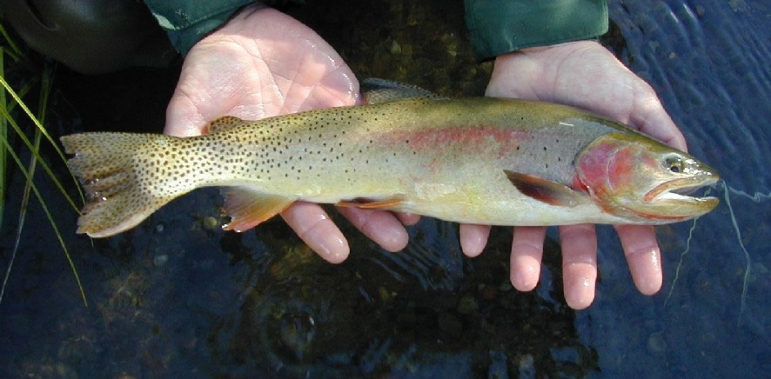
CODY, WYO. — Efforts to restore native Yellowstone cutthroat trout have made headlines in recent years, with a focus on reducing invasive lake trout in Yellowstone Lake, the largest body of water in Yellowstone National Park.
But a new front in the war against non-native trout could be developing just east of the park next year, if the Wyoming Game and Fish Department moves forward with a plan to create a safe harbor for Yellowstone cutthroats in the Shoshone National Forest.
The goal would be to create a protected Yellowstone cutthroat population upstream from a natural barrier, said Jason Burckhardt, a WGFD fisheries biologist. He outlined the plan during a March 5 public lecture at the Buffalo Bill Center of the West.
Yellowstone cutthroat are an important food source for grizzly bears and many other species across the region, and biologists are working to restore the native fish to waters where invasive trout have flourished, upsetting the natural balance.
Under a proposal that would require public comment and review under the National Environmental Policy Act, biologists would remove brook trout from the area around Eagle Creek meadows, in the Washakie Wilderness, less than five miles from the eastern boundary of Yellowstone.
Biologists would then restock the upper portions of Eagle Creek with Yellowstone cutthroats, and an existing natural waterfall downstream would prevent rainbow trout and other non-native fish from moving upstream into the protected areas.
While non-native lake trout are the biggest problem in Yellowstone Lake, it’s rainbow trout and brook trout that are causing problems in the North Fork of the Shoshone River, Burckhardt said.
More than 250 miles of nearby waterways were once home to Yellowstone cutthroats, but currently, only one 8-acre lake and a nearby quarter-mile inlet in the Beartooth Mountains still has genetically pure Yellowstone cutthroats, he said.
Rainbow trout cross-breed with Yellowstone cutthroats, with resulting hybrids becoming dominant. Brook trout also tend to out-compete Yellowstone cutthroats, as they have done in the upper Eagle Creek area, Burckhardt said. Brook trout may have been stocked above the Eagle Creek falls as early as 1913, he said.
Using methods that have been successful in other fishery restoration projects, Game and Fish biologists plan to treat sections of Eagle Creek with rotenone, a chemical compound that is toxic to fish. Burckhardt said the rotenone would be neutralized by additional chemical treatments downstream before it affects other fisheries, and that it would generally not pose a threat to people or land-based wildlife.
The upper Eagle Creek area is a good candidate restoration zone for Yellowstone cutthroats because it is home only to brook trout. The fishery around Eagle Creek Meadows typically produces brook trout of six inches or less, he said, while it would likely prove better habitat for Yellowstone cutthroat.
The process would take a couple of years, and would not start until fall 2016, Burckhardt said. If successful, it could create a safe haven for Yellowstone cutthroats that could ensure a foothold for the fish in the North Fork of the Shoshone River for decades to come.
Dave Sweet, a Trout Unlimited member who has led efforts to restore Yellowstone cutthroats, said he wholeheartedly supported the plan.
“We’ve lost a lot of the core population of Yellowstone cutthroat, so we have to get very aggressive about trying to protect the few that remain,” Sweet said. “That includes boosting the population by supplementing in places like Eagle Creek.”
For a half-century or longer, locals have cherished Eagle Creek Meadows as a favorite brook trout fishery, which could make the Yellowstone cutthroat restoration plan unpopular with some.
Sweet said there may be some outfitters, guides and backcountry anglers who will be upset at the prospect of two or three years without fish in Eagle Creek Meadows.
“But from an angler’s standpoint, I’d much rather catch cutthroat than brook,” Sweet said. “And I would hope that people will realize the short-term inconvenience is worth it in the long run.”
Sweet said the Eagle Creek plan would be helpful in restoring Yellowstone cutthroat along the North Fork, but that many more such repopulation efforts will be necessary for ultimate success.
Contact Ruffin Prevost at 307-213-9818 or [email protected].

Neither rainbows nor brookies are native trout. Please restore the native Yellowstone Cutthroat where you can. The entire ecosystem benefits.